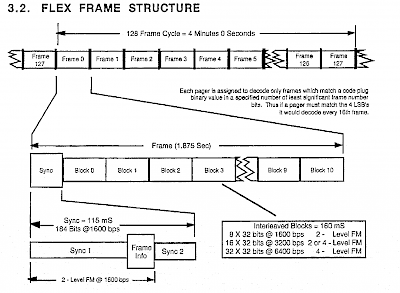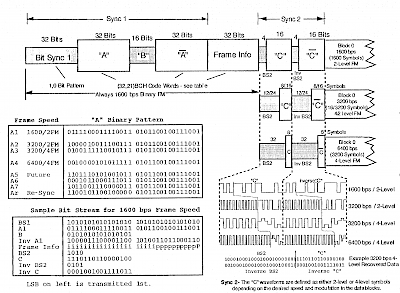Sync and header
In a world where your cellphone doesn't even last an entire day of regular use, the pager is rather special. Using a very nice time-division scheme, FLEX network operators can decide
 to have pagers listen for pulses on the radio channel for only a very short while. This has a positive effect on battery life. FLEX effectively divides a period of 4 minutes up into 128 frames of 1.875 seconds. Depending on 'System Frame ID Collapse' , the network instructs the pager to only listen to one of the 128 frames, or every X frames. Listening once every 4 minutes has a pretty dramatic effect on battery life, where batteries may last for months without replacing.
to have pagers listen for pulses on the radio channel for only a very short while. This has a positive effect on battery life. FLEX effectively divides a period of 4 minutes up into 128 frames of 1.875 seconds. Depending on 'System Frame ID Collapse' , the network instructs the pager to only listen to one of the 128 frames, or every X frames. Listening once every 4 minutes has a pretty dramatic effect on battery life, where batteries may last for months without replacing.
Of course, this requires the base station to postpone transmissions until the pager shall be listening. Worst case, you'll get a 4 minute delay in message reception
Every 1.875s long frame consists of a 3-part header and 11 datablocks.
First part of the header is 112 bits long.
- BS: 32-bit bitsync word (1,0,1,0), to train the receiver to the bitrate and phase.
- A(1): 32-bit word to indicate the speed of the 3rd part of the header and block
- B: 16-bit bitsync word (0,1,0,1)
- ~A(1): Inverted A segment
Then, a 32-bit Frame Information Word is transmitted. This contains the following information:
+----+----+----+----+----+----+----+----+----+----+----+----+----+----+----+---+---+----+----+----+----+------------+--------+ | x0 | x1 | x2 | x3 | c0 | c1 | c2 | c3 | f0 | f1 | f2 | f3 | f4 | f5 | f6 | n | r | t0 | t1 | t2 | t3 | 10 bit CRC | parity | +----+----+----+----+----+----+----+----+----+----+----+----+----+----+----+---+---+----+----+----+----+------------+--------+
- c 4-bit cycle number (0 to 14);
- f 7-bit frame number (0 to 127);
- n reserved bit (0)
- r Repeat Paging indicator
- t 4-bit indicator
- r=1: Repeat format on t0-3
- r=0: Low traffic per phase (D/C/B/A)
- t(n) Address frames contained in block 0 for phase (n)
- x 4 bit checksum
The third part is sent in the bitrate and FSK level as indicated by block A, for 1600 baud / 2-level FSK:
- BS2: 4-bit bitsync (1,0,1,0)
- C: 16-bit word
- ~BS2: 4-bit bitsync (0,1,0,1)
- ~C: 16-bit word
The patent has a pretty nice drawing explaining the sync-header
